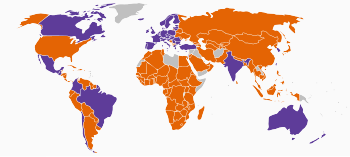
Back اختبار مستحضرات التجميل على الحيوانات Arabic Pruebas de cosméticos en animales Spanish آزمایش لوازم آرایشی روی جانوران FA ניסויים בבעלי חיים בתעשיית הקוסמטיקה HE 화장품동물시험 Korean Тестування косметики на тваринах Ukrainian Thử nghiệm mỹ phẩm trên động vật VI 化妆品动物实验 Chinese
Parts of this article (those related to documentation) need to be updated. (July 2022) |

| | Nationwide ban on all cosmetic testing on animals | | Partial ban on cosmetic testing on animals1 |
| | Ban on the sale of cosmetics tested on animals | | No ban on any cosmetic testing on animals |
| | Unknown |
| Part of a series on |
| Animal rights |
|---|
| Animal testing |
|---|
 |
| Main articles |
| Testing on |
| Issues |
| Cases |
| Companies |
| Groups/campaigns |
|
| Writers/activists |
| Categories |
Cosmetic testing on animals is a type of animal testing used to test the safety and hypoallergenic properties of cosmetic products for use by humans.
Since this type of animal testing is often harmful to the animal subjects, it is opposed by animal rights activists and others. Cosmetic animal testing is banned in many parts of the world, including Colombia, the European Union, the United Kingdom, India,[1][2] and Norway.[3]
Cosmetics that have been produced without any testing on animals are sometimes known as "cruelty-free cosmetics".[4] Some popular cruelty-free beauty brands include: E.L.F., Charlotte Tilbury, Farsali, Fenty Beauty, Fenty Skin, Glow Recipe and others. The website "Cruelty-Free Kitty" was created to assess which brands are cruelty-free. [5] Furthermore, some brands have participated in animal testing in the past, however, if they currently do not test on animals, these cosmetics are considered "cruelty-free".[6]
- ^ Engebretson, Monica (23 July 2013). "India Joins the EU and Israel in Surpassing the US in Cruelty-Free Cosmetics Testing Policy". HuffPost. Retrieved 6 June 2020.
- ^ Cite error: The named reference
HSUSwas invoked but never defined (see the help page). - ^ Cite error: The named reference
US Billwas invoked but never defined (see the help page). - ^ ""Cruelty-Free"/"Not Tested on Animals"". US Food and Drugs Administration. September 2020. Retrieved 28 July 2021.
- ^ "List of Officially Cruelty-Free Brands (2024 Update)". www.crueltyfreekitty.com. 20 October 2024.
- ^ "Myth: If a product says "Cruelty-Free" or has a bunny on it, that means it has not been tested on animals". www.leapingbunny.org.